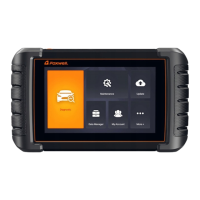
Do you have a question about the Foxwell NT809BT and is the answer not in the manual?
| Operating System | Android |
|---|---|
| RAM | 2GB |
| Storage | 16GB |
| Resolution | 1024 x 600 pixels |
| Processor | Quad-core |
| Connectivity | Wi-Fi, Bluetooth |
| Protocols | CAN |
| Languages | Multiple languages |
Details the conditions, exclusions, and procedures related to the one-year limited warranty for the product.
Explains the use of bold text for highlighting UI elements and menu options within the manual.
Describes the meaning of various symbols and icons used to convey information and procedures in the manual.
Details the external features, ports, and connectors of the NT809BT diagnostic scanner.
Explains how the VCI dongle connects to the vehicle for data communication via Bluetooth or USB.
Lists all accessories that are packaged with the NT809BT scanner for user reference.
Provides detailed technical specifications of the NT809BT scanner, including hardware and system details.
Instructions on how to power up the scanner using the internal battery or external power supply.
Steps required to properly shut down the NT809BT scanner, ensuring all communication is terminated.
Explains the layout of the scanner's home screen and the application menu interface.
Details the functions and button operations available within the diagnostic menu screen.
Steps to establish communication between the VCI dongle and the NT809BT tablet for vehicle testing.
Methods for reading the vehicle's identification number (VIN) using the scanner.
Detailed steps for automatically identifying a vehicle by reading its VIN.
Instructions on manually inputting the VIN to identify the vehicle.
Guide to selecting a vehicle by brand, area, and model criteria.
Process for identifying a vehicle using the Smart VIN feature.
Step-by-step guide for manual vehicle identification using various selection criteria.
How to access and utilize vehicle history records for faster diagnostic identification.
Procedures for identifying installed control modules within a vehicle after initial identification.
Performs an automatic scan to identify control modules and overview diagnostic trouble codes (DTCs).
Lists available vehicle controllers for technicians familiar with specific vehicle configurations.
General overview of common diagnostic operations including reading codes, live data, and ECU information.
Explains how to read diagnostic trouble codes (DTCs) and their various status types.
Instructions for clearing current and stored DTCs from selected control modules.
How to view real-time PID data in text and plot formats for sensor analysis.
Displays all available live PID data from a selected control module.
Minimizes displayed PIDs to focus on suspicious or symptom-specific data parameters.
Procedure for recording live data for later review and analysis.
Displays multiple PID parameters in waveform graphs simultaneously for comprehensive analysis.
Merges multiple PID plots into a single coordinate for easier comparison and analysis.
Displays identification data of the control module under test, including hardware and software information.
Resets service indicator lamps on the instrument cluster after vehicle maintenance.
Performs service and maintenance on brake systems, including deactivation and pad replacement.
Validates a new battery to the vehicle's ECU and clears dashboard warning lights post-replacement.
Cleans the Diesel Particulate Filter (DPF) by burning captured particulates.
Calibrates the throttle body for proper engine idle control by learning its full motion range.
Calibrates the steering angle sensor to store the straight-ahead wheel position.
Resets compensation codes and initializes the ECT after solenoid valve or valve body replacement.
Learns crankshaft tolerance for accurate engine misfire diagnosis, especially after component replacement.
Resets tire pressure after maintenance and turns off the related warning light.
Rewrites injector codes to the ECU for accurate cylinder injection quantity control.
Removes air from the brake system after component replacement to ensure a firm brake pedal.
Programs transponder keys for vehicle ignition and security system access.
Allows review, saving, and management of stored screenshots for troubleshooting or documentation.
Guides users on how to create and save vehicle test reports in PDF format.
Enables review of recorded live data in text, graph, and merged graph formats.
Guides users through registering a FOXWELL ID via the built-in client or the official website.
Instructions for signing into the user account and activating the device.
Allows users to check and modify their account details like username, email, and address.
Manages activated products, including serial numbers and expiration dates.
Provides a channel for users to send feedback and suggestions regarding Foxwell products.
Explains how to enable automatic update notifications for new software versions.
Guides users through the process of manually updating the diagnostic application software.
Allows changing the unit system between Imperial customary and metric units of measure.
Enables the selection of the system language for the scanner interface.
Allows users to change the font size of the application for better readability.
Configures the sorting method for vehicle brands, by alphabet or frequency of use.
Allows selection of remote control tools like TeamViewer QuickSupport or AnyDesk.
Enables or disables automatic update notifications for new software versions.
Provides direct access to the Android system settings for sound, display, and security.
Controls prompts when saving files or during login and registration.
Allows uninstallation of specific vehicle software installed on the scanner.
Clears cache data of applications to improve device operation and performance.
Configures printer connections for printing data and reports via PC network or Wi-Fi.
Displays information about the scanner, including serial number, hardware, and software versions.
Guide on using TeamViewer QuickSupport for remote control and technical assistance.
